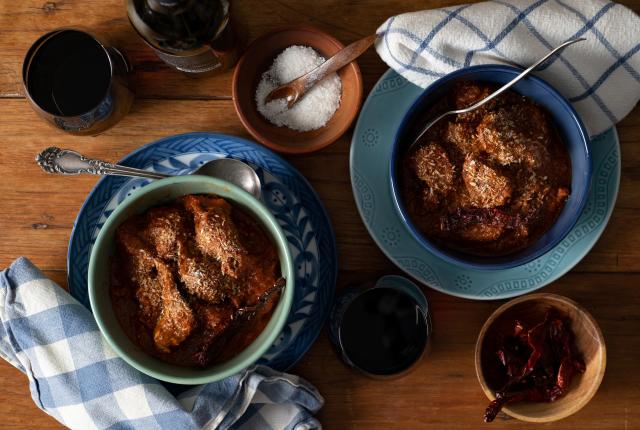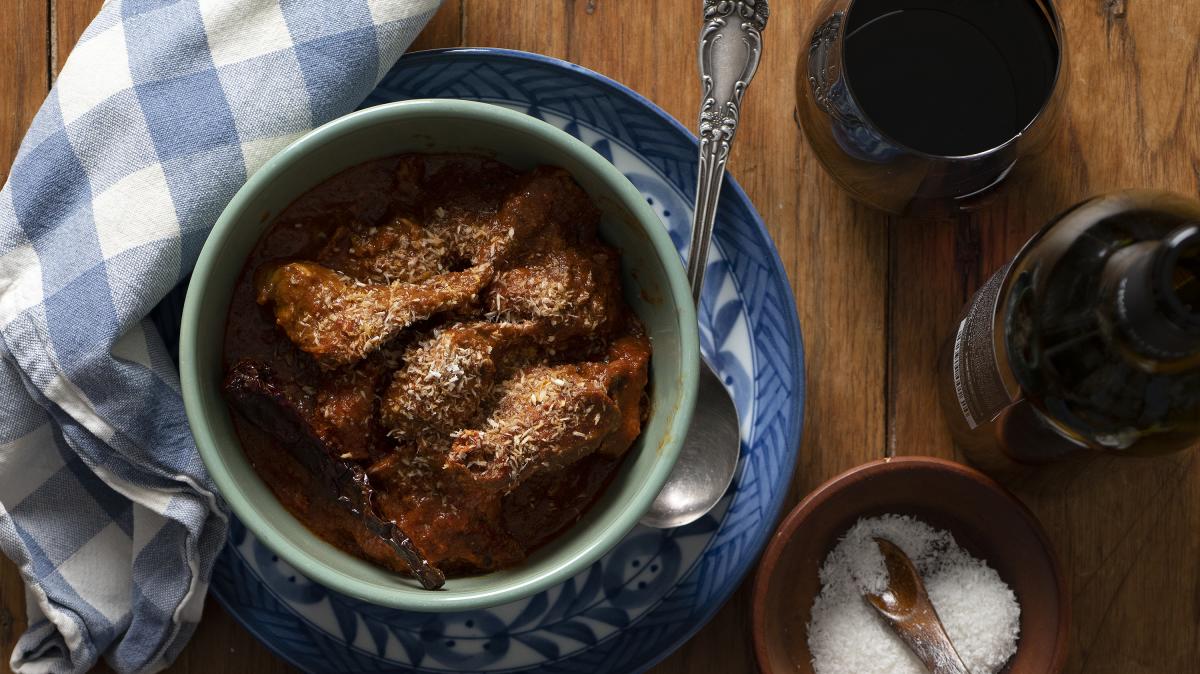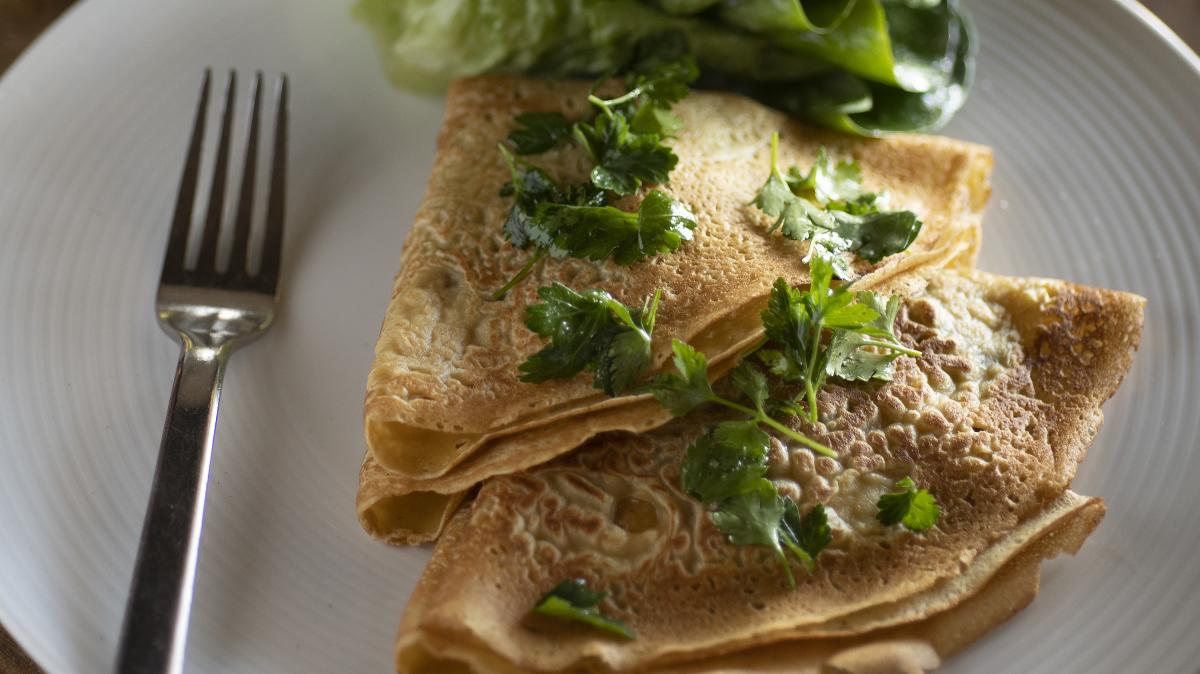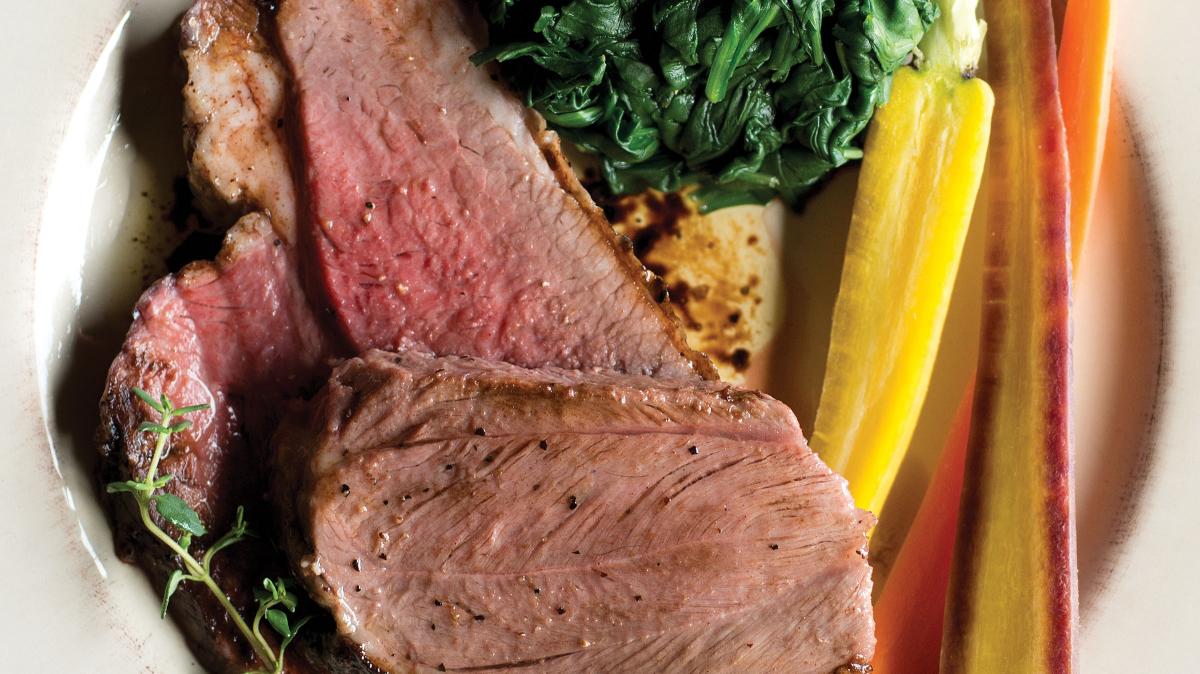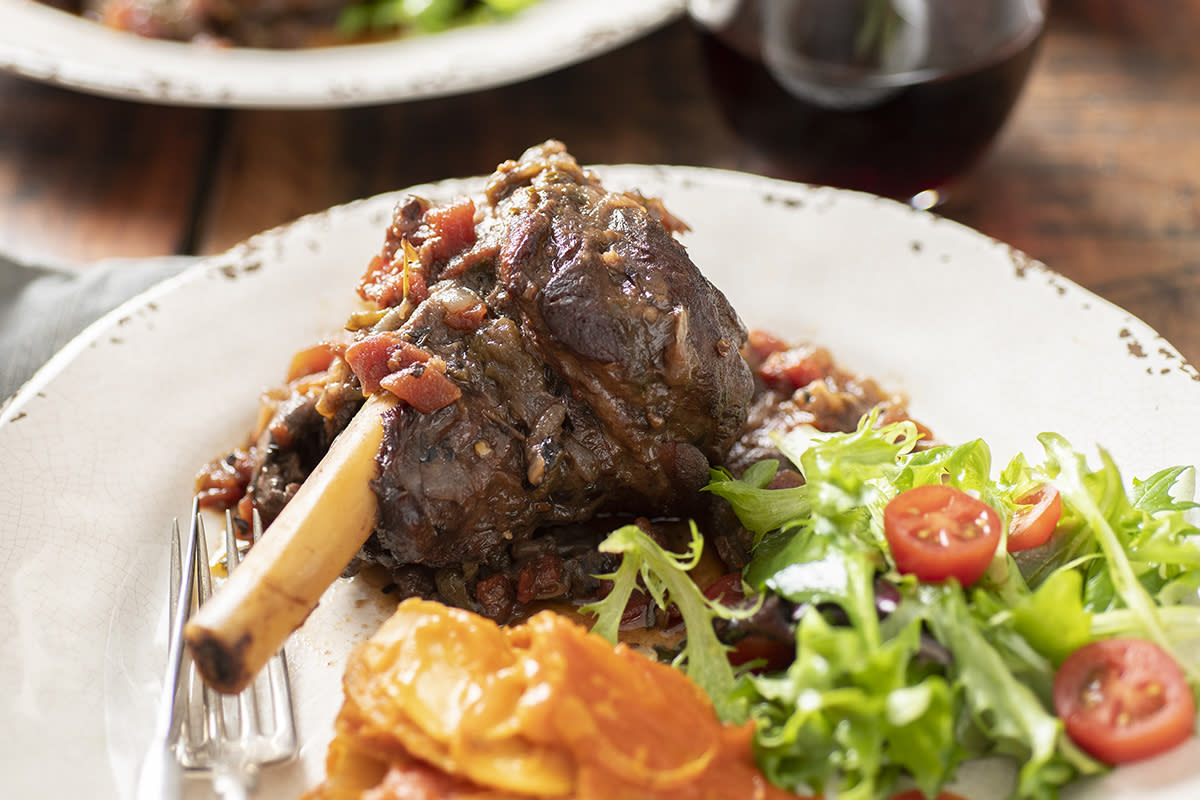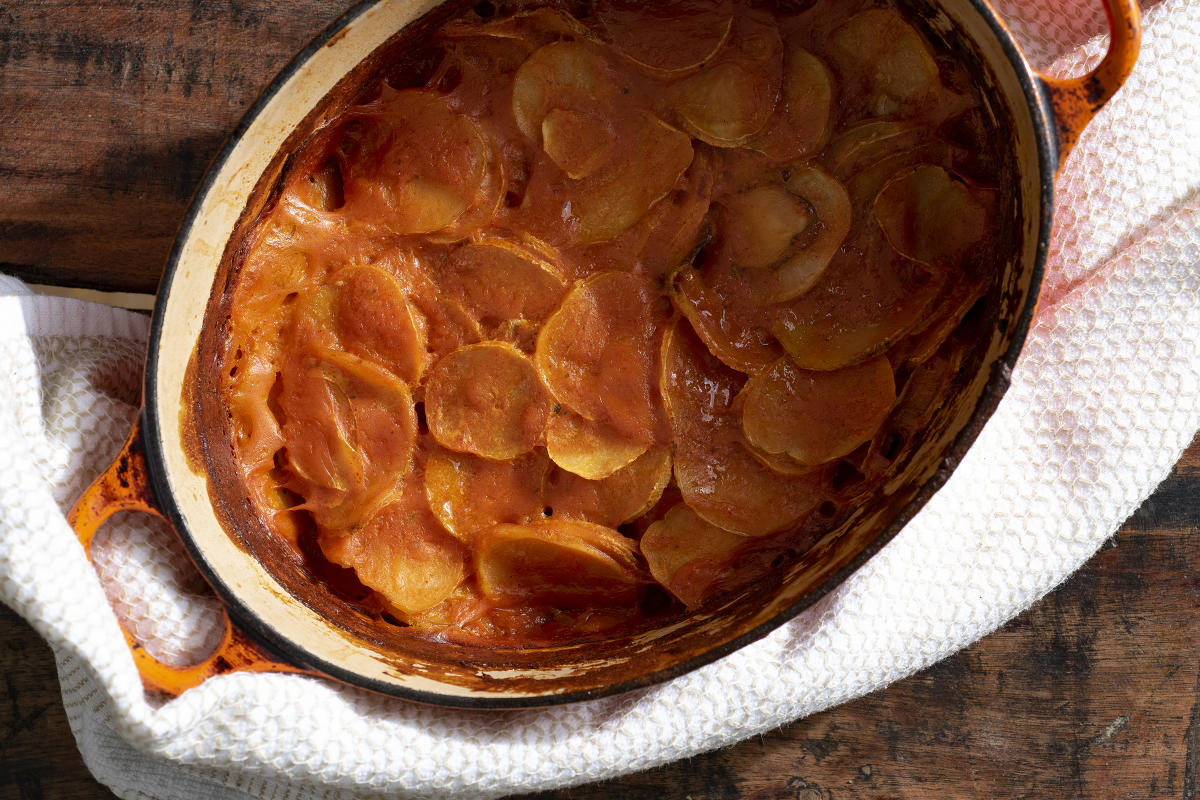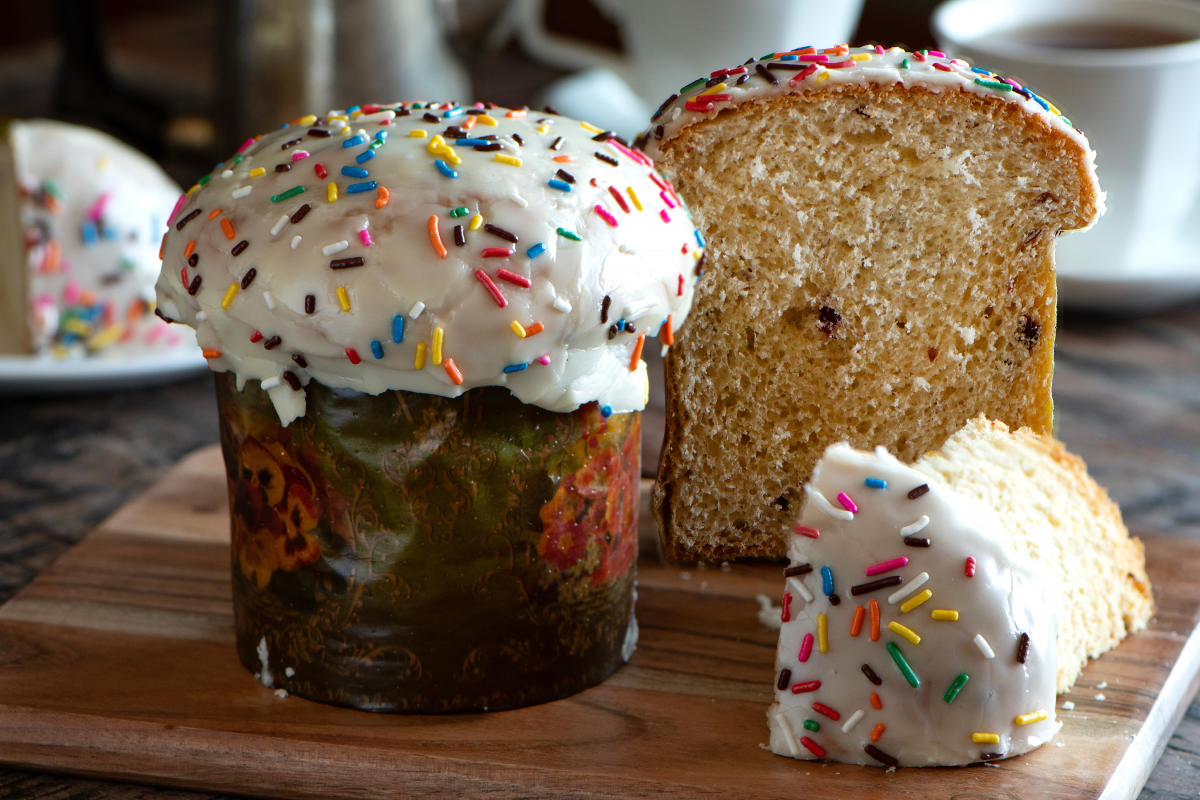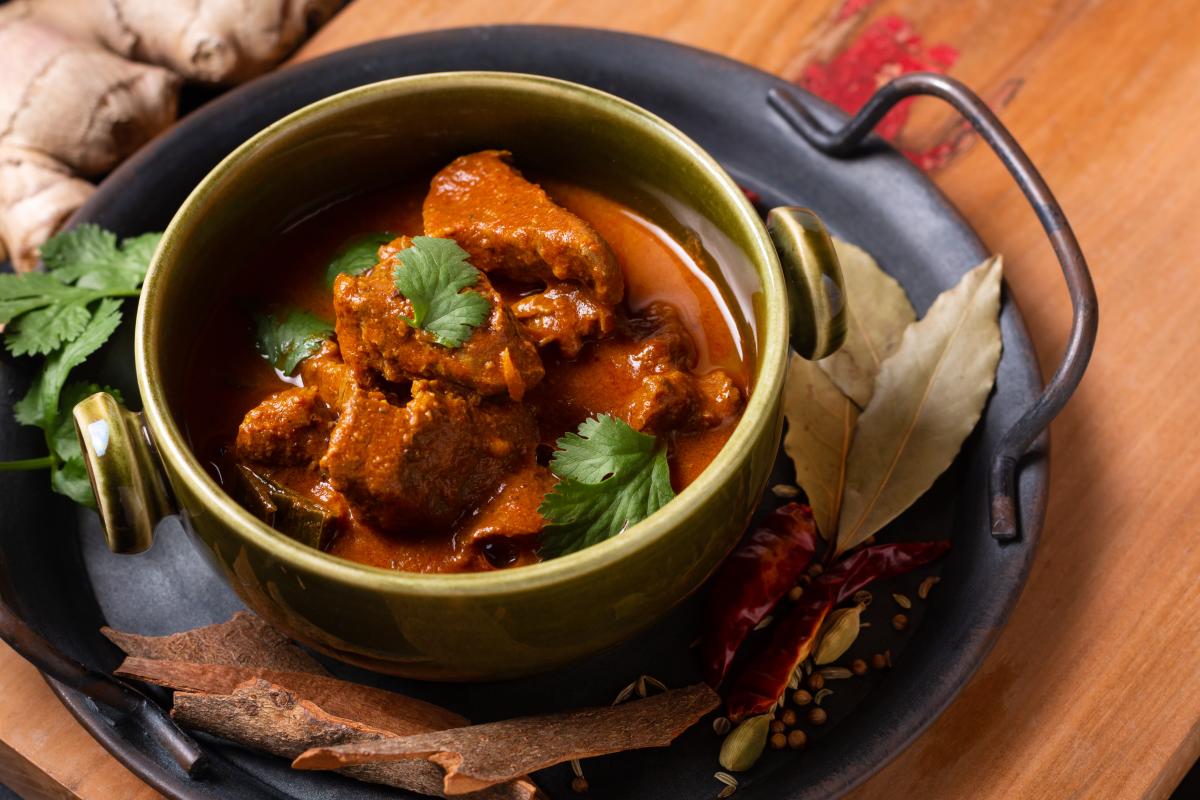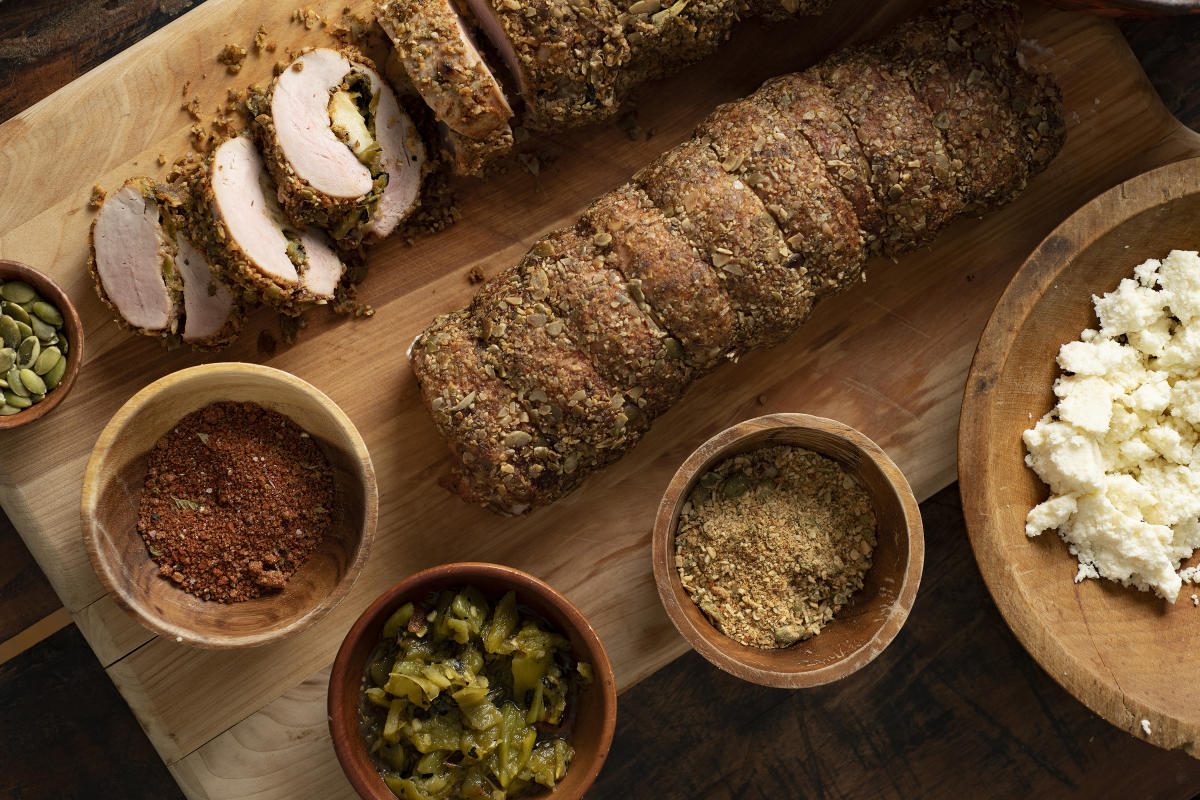Chef Paddy Rawal’s dish has origins in Portugal, as a stew marinated in wine vinegar and garlic, called carne de vinha d’alhos (meat in garlic marinade). Portuguese traders transported spices throughout the world. In Goa, the locals added their own favorite flavors to create vindaloo. It’s typically very spicy, but you can vary the heat by decreasing the amount of chile.
STEW
1½ pounds boneless lamb stew meat, cut into 1-inch cubes
14 tablespoons olive oil (¾ cup plus 2 tablespoons), divided
1 cup red onion, chopped
3 medium potatoes, peeled and cubed
5 cups chicken stock
MARINADE
6 red chiles, fresh or dried, seeded and roughly chopped (choose a mild chile, like Fresno)
8 sticks of cinnamon (or substitute 4 teaspoons ground)
½ cup rice vinegar
1 teaspoon black pepper, crushed
SAUCE
2 tablespoons garlic, chopped
2 tablespoons fresh ginger, chopped
1 tablespoon sugar
8 green cardamom pods
8 cloves, whole
3 Thai green chiles, stemmed
1 teaspoon cumin seeds
4 teaspoons coriander seeds
¼ teaspoon turmeric
2 28-ounce cans of whole peeled tomatoes
Serves 4
INSTRUCTIONS
-
Prepare the lamb by rinsing it in cold water, blotting dry with paper towels, and trimming any excess fat.
-
Prepare the marinade by grinding the red chiles and cinnamon sticks in a blender. Place in a large bowl and stir in vinegar and pepper. Stir in the lamb and allow to marinate, covered and refrigerated, for an hour.
-
Place all sauce ingredients in a clean blender and purée until smooth.
-
Heat half of olive oil in a large sauté pan and fry the potatoes until slightly softened and lightly browned; set aside.
-
Heat remaining oil in a heavy-duty Dutch oven, add the onions, and sauté on medium heat until golden brown. Stir in the sauce and cook until the onions soften.
-
Add the lamb and simmer for 6 minutes. Add stock, bring to a boil, then reduce to low, cover, and simmer until lamb is tender, about 20 minutes. Add the potatoes. Serve.
Chef Jonathan Perno, a six-time semifinalist for the heralded James Beard Award, often orders whole lamb from Shepherd’s Lamb to experiment with different cuts. This past winter, he cured and smoked trimmings from the rack, turning it into lamb bacon for spaghetti carbonara.
FILLING
¼ cup olive oil
3 tablespoons butter
2 pounds lean ground lamb
6 cloves garlic, minced
1 medium onion, large dice
4 ribs celery, large dice
1 pound fresh cremini mushrooms, stemmed and quartered
1 bay leaf
3–4 sprigs rosemary
¼ cup flour
1 cup dry white wine or dry vermouth
1 quart chicken stock
1 cup heavy cream
Salt and black pepper to taste
Parsley sprigs for garnish
CREPES
1 cup plus 1 tablespoon milk
1 cup plus 1 tablespoon beer
6 tablespoons clarified butter, plus additional for crepe pan (or use spray)
1¾ cups flour, sifted
½ teaspoon salt
2 teaspoons sugar
3 eggs
Serves 6-8
INSTRUCTIONS
-
To make crepes, warm milk and beer to 110° in a small pan or microwave. In a separate dish, melt clarified butter and set aside.
-
Mix flour, salt, and sugar in a large bowl and whisk into milk-and-beer mixture. Stir in butter, then eggs, one at a time. Strain batter and chill for 24 hours.
-
Heat a crepe pan or 8-inch nonstick skillet over medium heat. Butter pan or spray with nonstick spray. Stir batter and place one ladleful (or use a ¼ cup or ⅓ cup measure, depending on size of crepe desired) in heated pan. Swirl pan to move batter into a round. When crepe begins to peel up from sides of pan and some color has formed, flip and cook on other side for about 30 seconds.
-
Place on a parchment-lined plate and keep warm in a 200° oven until ready to plate. Keep cooking and separating the crepes with parchment. (They can also be refrigerated, then reheated in the oven. Wrap extra crepes in plastic and freeze.)
-
To make filling, melt butter with olive oil in a large pot over medium heat. When hot, add lamb and stir gently to break it up. Season with salt and pepper and cook until golden brown, about 10 minutes. Add garlic, onion, celery, mushrooms, bay leaf, and rosemary. Sauté 3–5 minutes.
-
Sprinkle flour over the meat and stir to combine. Cook 2 minutes longer.
-
Deglaze the mixture with wine or vermouth and allow to simmer until it has reduced by half.
-
Add chicken stock and cream and let come to a boil, stirring often to prevent sticking. Lower heat and simmer, stirring occasionally, about 30 minutes. Remove rosemary and bay leaf, adjust seasoning to taste.
-
To plate, place ⅓ cup filling in a quadrant of a crepe. Fold crepe in half, then fold the half into a quarter and place on warm serving plate. Garnish with parsley.
- 3 tablespoons olive oil
- 4 cloves garlic, minced
- 1 boneless leg of lamb, about 3 pounds
- 1/2 pound spinach
- 1 small onion, chopped fine
- Salt and pepper to taste
Serve 4–6
- Combine 2 tablespoons of olive oil with 3 cloves of minced garlic and mix well. Rub this mixture all over the lamb, then sprinkle with salt and pepper and place in a roasting pan.
- Cook the lamb in a preheated 450° oven for 15 minutes, then reduce the heat to 350° and cook another 30 minutes. Check the internal temperature with a meat thermometer. It should read 130° for medium rare with a pink center. A reading of 150° will give you medium well with no pink meat. Remove the lamb from the oven and let sit for 15 minutes before carving into thick slices.
- While the lamb rests, wash the spinach, and gently shake to remove excess water. Heat the remaining tablespoon of olive oil in a skillet over medium heat and sauté the onion 3–4 minutes until translucent. Add the remaining garlic and sauté for another minute. Place the spinach on top of the garlic and onion and put a lid over the skillet. Wait a minute or two, allowing the heat in the skillet to build up, then turn off the heat. The spinach will wilt nicely in 5–6 minutes. Mix the spinach, onion, and garlic, add salt and pepper to taste. Serve with carved lamb.
I think osso buco—Italian for “bone with a hole”—made with lamb shanks is so much tastier than the traditional version, made with veal shanks. You may find shanks that are crosscut as in the traditional veal version (ask your butcher), but whole shanks work, too. Check the meat after two hours; you don’t want the lamb to fall completely off the bone but to pull away easily. Serve with a potato side dish or wild mushroom risotto. Osso buco is great for entertaining. You can cook it completely, then rewarm when you’re ready to serve.
4 lamb shanks, approximately 10 ounces each
2 teaspoons kosher salt, divided
2 teaspoons freshly ground black pepper, divided
½ cup flour
4 tablespoons olive oil
4 garlic cloves, minced
1 large yellow onion, diced
1 cup mushrooms, quartered
2 tablespoons fresh thyme leaves
14.5-ounce can diced tomatoes, with their liquid
4 cups chicken stock
1 cup dry red wine like merlot or cabernet
1–2 bay leaves
1 cup New Mexico green chile (mild or hot), roasted, peeled, seeded, and chopped
Sprigs of parsley
Serves 4
INSTRUCTIONS
- Mix together 1 teaspoon salt and 1 teaspoon pepper with the flour, and dust the shanks on all sides. Place olive oil in heavy-bottomed Dutch oven or roasting pan and brown shanks on all sides over medium heat. Remove shanks from Dutch oven or pan and set aside.
- Turn heat up to medium high and add garlic, onions, and mushrooms to Dutch oven or pan. Sauté until onions start to brown.
- Add thyme, tomatoes, stock, and wine to Dutch oven or pan. Allow liquid to come to a boil. Stir in remaining salt and pepper and bay leaves and green chile. Nestle the shanks into the sauce; they may not be completely covered with liquid, but that’s fine.
- Cover Dutch oven or pan, place in preheated 400° oven, and cook for approximately 2½ hours. The dish is done when shanks are very tender and almost falling off the bone. Serve in a bowl with “gravy” ladled over it, topped with parsley.
These rich and creamy scalloped potatoes are a perfect side dish for your favorite lamb, pork, or other protein. Using a mandoline to slice the potatoes works well. For my vegetarian friends, I grill a thick slab of olive-oiled and well-seasoned eggplant and serve that as a “steak” to accompany this dish.
3 medium potatoes (or sweet potatoes), washed, peeled, and sliced ⅛ inch thin
4 egg yolks, lightly beaten
1 cup heavy cream
2 cups milk
1 cup sour cream
1 cup shredded sharp cheddar cheese
¼ cup mild New Mexico red chile, ground
1 teaspoon hot New Mexico red chile, ground
1 teaspoon cumin, toasted and ground
1½ teaspoon salt
Butter for casserole
Black peppercorns
Serves 6–8
INSTRUCTIONS
- Preheat oven to 400°. Spread potato slices on paper towels and blot dry. (If you live above 4,000 feet elevation, blanch the sliced potatoes in salted boiling water for 5 minutes. Drain and blot on paper towels.)
- In a medium bowl, whisk together yolks, cream, milk, sour cream, cheese, mild and hot red chiles, cumin, and salt.
- Butter a 4- to 5-quart casserole dish. Alternate 4 layers of potatoes and ladles of the milk mixture. Crack black pepper over potatoes.
- Cover with the casserole lid or foil and bake for 30 minutes. Uncover and continue baking until casserole is bubbling and nicely browned, about 20 minutes. Test for doneness by inserting the tip of a sharp knife into the center of the dish, making sure potatoes are tender.
Paska (or kulich) is a traditional Ukrainian sweet bread/cake served at Easter. “The tall cylindrical cake is similar to artos (leavened bread blessed at Eastern Orthodox and Byzantine Catholic churches), Toczek says. “Traditionally, it is baked on Maundy (Holy Thursday).”
- 135 grams (about ½ cup) milk
- 10 grams (3/4 tablespoon) dry yeast (or 50 grams fresh yeast)
- 180 grams (almost 1 cup) sugar, divided
- 550 grams (4 ½ cups) all-purpose flour, divided
- 2 eggs
- 40 grams (3 tablespoons) sunflower oil
- 50 grams (¼ cup) sour cream
- 100 grams (½ cup) cream cheese
- 70 grams (about 1/3 cup) unsalted butter
- 2 grams (1/3 teaspoon) salt
- 9 grams (2 teaspoons) vanilla sugar
- 1 cup dried fruits, plus more for garnish
GLAZE
- 1 to 2 oranges, juiced
- Powdered sugar
- Sprinkles, optional
- Special equipment: 5 baking molds, approximately 5 by 4 inches. You can use spring pans; silicone or panettone paper molds; or parchment-paper-lined coffee cans (baking times vary depending on the size of your molds)
Note: All ingredients should be room temperature and all dry ingredients should be sifted.
Makes 5 servings
FOR THE STARTER:
- In a tall bowl, mix milk, yeast, 1 tablespoon sugar, and 3 tablespoons flour. Cover the bowl with plastic wrap and leave in a warm place for 10 to 15 minutes until foamy.
FOR THE DOUGH:
- Whisk eggs with the rest of the sugar in a stand mixer bowl until a voluminous, lush mass forms.
- Change out whisk attachment for bread hook; add the rest of the ingredients, except the flour and dried fruits. Mix well.
- Add the starter and mix on low speed, gradually adding the rest of the flour.
- Once all flour has been added, mix on medium speed until the dough stops sticking to the bowl. You can also knead the dough by hand.
- Cover the bowl with a towel and let it proof 1 to 2 hours, no longer. The mixture should have doubled in size.
- Preheat oven to 320°.
- Mix dried fruits into the dough.
- Layer the bottom and sides of your baking molds with parchment paper.
- Divide the dough into portions, about 290 grams each. Each portion should not exceed one-half of the height of your mold.
- Place the molds in a warm spot and let them proof until dough reaches the top of the molds.
- Bake 30 to 35 minutes. The breads should be golden brown and the inside temperature should be 203° to 205°. If the tops are getting too dark before they are ready, cover tops with foil, shiny side down, and bake until done.
- Take paskas out of the oven and let sit for 5 to 10 minutes. Then remove from the molds so they don’t get soggy.
FOR THE GLAZE:
- In a bowl, mix juice and powdered sugar until desired thickness (the thicker the consistency, the whiter the glaze will be).
- Dip the tops of cooled paskas into the glaze. Decorate with sprinkles or dried fruits.
- ½ cup dried currants
- 3 tablespoons New Mexico red wine
- 2 tablespoons olive oil
- 1 pound ground lamb
- 1 small red onion, minced
- ½ cup green olives, chopped
- ½ cup feta cheese
- salt and pepper to taste
- 1 egg
- 1 box frozen puff pastry, thawed
- overnight in refrigerator
7 EMPANADAS
FILLING
- Soak currants in red wine 10 minutes.
- In large sauté pan, warm olive oil over medium heat. Add ground lamb. Using spoon or spatula, break up lamb pieces as meat cooks (3–4 minutes). Add red onion, wine-soaked currants, olives, and mix thoroughly. Remove from heat and add feta cheese. Season with salt and pepper. Let mixture cool slightly before assembling empanadas.
ASSEMBLY
- Preheat oven to 400 degrees. Whisk together egg and 2 tablespoons water.
- Place one sheet puff pastry on flat, lightly floured surface. Roll out pastry to about half its original thickness. Cut into 10 or 12 equal squares.
- Place 1 heaping tablespoonful of filling in center of each square. Brush edges of squares lightly with egg-and-water mixture. Fold each square in half to form triangle. Using a fork, crimp edges of squares, and pierce top once to create steam vents. Arrange on lightly oiled cookie sheet and brush top of each empanada with remaining egg wash.
- Bake 8–10 minutes or until golden brown. (Check often—oven temperatures vary dramatically!) Let cool before serving with Lemon Mint Cream.
Lamb is a traditional meal in northern New Mexico. This preparation incorporates spicy chile—another New Mexican tradition, to be sure!
- 2 tablespoons vegetable oil
- 1½ pounds lamb stew meat, cut in ½-inch cubes, drained, patted dry
- 1 large yellow onion, diced
- 4 cloves garlic, minced
- 1 tablespoon salt
- 1 cup New Mexico red-chile powder
- (mild or medium)
- 1 teaspoon ground cumin
- 1 teaspoon ground coriander
- 1 teaspoon dried oregano
- ½ cup New Mexico red wine
- 3 cups vegetable broth
- 1 tablespoon New Mexico honey
- salt and pepper to taste
- 1 teaspoon fresh rosemary, finely chopped
SERVES 4 TO 6
- Heat oil in heavy, large-bottomed soup pot over medium-high heat. Add lamb stew meat, evenly covering bottom of pot.
- Let lamb brown 8–10 minutes before stirring, then cook another 5 minutes. Add onion and garlic. Cook 5 minutes more, stirring occasionally. Add salt, chile powder, cumin, coriander, and oregano. Cook another 2–3 minutes, stirring constantly, until very fragrant.
- Add wine and cook 1 minute. Add vegetable broth, reduce heat to simmer, and add honey. Simmer 30 minutes or until lamb is tender.
- Adjust seasonings with salt and pepper, and finish with fresh rosemary. Serve over steamed rice with dollop of sour cream and warm flour tortillas.
Chris Maher teaches a class called New Mexican with a Twist at his Cooking Studio Taos. “It means modernizing the cuisine to a certain extent, without bastardizing it,” he explains. “For example, my red chile has chocolate and cinnamon in it. However, the quantities are small so that it augments the actual chile flavor, gives it legs. These additions are imperceptible, but people enjoy what happens in their mouth, on their palate.”
- 1 rack organic, grass-fed lamb ribs
- 1 teaspoon garlic powder
- 1 teaspoon onion powder
- 1 teaspoon cumin
- 1/4 cup medium-hot red chile
- 1 tablespoon kosher salt
- 1 teaspoon black pepper
- 1 ounce white vinegar
- 2 tablespoons molasses
- Place lamb in a pot, cover with water, and add garlic powder, onion powder, cumin, red chile, salt, pepper, and vinegar.
- Bring to a boil, reduce heat, and simmer for 45 minutes. Let cool and then refrigerate in the broth overnight.
- The next day, remove the ribs and pour the broth into a saucepan. Add molasses and simmer, reducing to a thick consistency (similar to a barbecue sauce).
- Place the ribs on a hot charcoal grill until black spots appear, basting constantly with the sauce. Remove from grill, let cool slightly, and cut into individual ribs to serve.
This tasty green chile–stuffed pork loin has a crunchy crust that helps keep the meat moist while roasting. Consider serving it with a simple sauce made by combining equal parts sour cream and salsa verde (Herdez is a popular brand). You can find queso fresco in most grocery stores near the cream cheese. Pepitas are often sold in bulk; I prefer the salted version. (Still determined to roast a ham? Start with spiral-cut. For a zippy norteño glaze, add ground New Mexico red chile to maple syrup or honey, or combine orange marmalade with canned chipotles.)
PORK
2 pork tenderloins, 1¼ pounds each
¾ cup New Mexico green chile (mild or hot), roasted, peeled, seeded, and chopped
4 ounces queso fresco
1 cup pepitas (shelled pumpkin seeds), toasted
2 egg whites, beaten until frothy
SANTA FE RUB
2 tablespoons brown sugar
1½ teaspoons mild New Mexico red chile, ground
1½ teaspoons hot New Mexico red chile, ground
¼ teaspoon black pepper
½ teaspoon kosher salt
½ teaspoon garlic salt
1 teaspoon Mexican oregano
1 teaspoon cumin seed, toasted and ground
Serves 6–8
INSTRUCTIONS
- Preheat oven to 375°. In a small bowl, mix the ingredients for the dry rub; set aside.
- Slice the queso fresco into 4-by-¼-inch logs; set aside.
- To butterfly the pork tenderloins, trim off any excess fat or silver skin on the outside. Using a sharp knife, slice down the middle of each loin, lengthwise. Go slowly and steadily. Don’t slice completely through the meat.
- Lay the pork on your cutting board, cover it with a piece of plastic wrap, and flatten the tenderloin using the smooth side of a mallet or tenderizer to an even ¼-inch thickness by approximately 5 inches across.
- Lightly season each pork surface with 1 teaspoon of the dry rub. Working lengthwise, place the chopped green chiles on the pork, slightly off the center. Set the queso fresco next to the chiles in the same direction.
- Roll the pork into a long log carefully over the filling, tucking in anything that falls out. Secure the roll as needed with 4–5 loops of butcher’s twine. Season each log with 1 teaspoon of the rub.
- Whirl the pepitas in a food processor or blender until they resemble coarse bread crumbs. Stir in 2 teaspoons of dry rub and place on a cookie sheet. Brush the meat with the egg whites and roll over the pepitas mixture, pressing to adhere.
- Place the pork in a sided baking dish and roast for 35–40 minutes, until the pork has at least a 145° internal temperature. Remove from the oven. Let rest about 10 minutes before slicing. Reserve leftover rub for another use.


